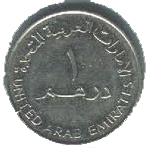|


The dirham (Arabic: درهم) (sign: د.إ; code: AED) is the currency of the United Arab Emirates. The ISO 4217 code (currency abbreviation) for the United Arab Emirates dirham is AED. Unofficial abbreviations include DH or Dhs. The dirham is subdivided into 100 fils (فلس).
History
The United Arab Emirates dirham was introduced December 1971. It replaced the Qatar and Dubai riyal at par. The Qatar and Dubai riyal had circulated since 1966 in all of the emirates except Abu Dhabi, where the dirham replaced the Bahraini dinar at 1 dirham = 0.1 dinar. Before 1966, all the emirates that were to form the UAE used the Gulf rupee. As in Qatar, the emirates briefly adopted the Saudi riyal during the transition from the Gulf rupee to the Qatar and Dubai riyal.
On January 28, 1978, the dirham was officially pegged to the IMF's Special Drawing Rights (SDRs). In practice, it is pegged to the U.S. dollar for most of the time. Since November 1997, the dirham has been pegged to the 1 U.S. dollar = 3.6725 dirhams, which translates to approximately 1 dirham = 0.272294 dollar.
The name Dirham derives from the Greek word Drachmae, literally meaning "handful", through Latin. Due to centuries of old trade and usage of the currency, dirham survived through the Ottoman regime.
For a wider history surrounding currency in the region, see The History of British Currency in the Middle East.
Coins
In 1973, coins were introduced in denominations of 1, 5, 10, 25, 50 fils, and 1 dirham. The 1, 5 and 10 fils are struck in bronze, with the higher denominations in cupro-nickel. The fils coins were same size and composition as the corresponding Qatar and Dubai dirham coins. In 1995, the 50 fils and 1 dirham coins were reduced in size, with the new 50 fils being curve-equilateral-heptagonal shaped.
The value and numbers on the coins are written in Eastern Arabic numerals and the text is in Arabic. The 1, 5 and 10 fils coins are rarely used in everyday life, so all amounts are rounded up or down to the nearest multiples of 25 fils. The 1 fils coin is a rarity and does not circulate significantly. In making change there is a risk of confusing the old 50 fils coin for the modern 1 dirham coin because the coins are almost the same size.
Since 1976 the Central Bank of the United Arab Emirates has minted several commemorative coins celebrating different events and rulers of the United Arab Emirates. For details, see Commemorative coins of the United Arab Emirates dirham.
Issues with fraud
By August 2006 it became publicly known that the Philippine one peso coin is the same size as one dirham . As 1 peso is only worth 8 fils, this has led to vending machine fraud in the U.A.E. The Australian ten cent coin is the same size, shape and weight as the U.A.E. Dirham. Pakistan's 5 Rupee coin, Omani 50 Baisa coin and the Moroccan Dirham is also the same size as U.A.E. one Dirham coin. A falcon watermark is present on all dirham notes in order to prevent fraud.
Banknotes
In 1973, the U.A.E. Currency Board introduced notes in denominations of 1, 5, 10, 50, 100 and 1000 dirham. A second series of note was introduced in 1982 which omitted the 1 and 1000 dirham notes. 500 dirham notes were introduced in 1983, followed by 200 dirham in 1989. 1000 dirham notes were reintroduced in 2000. Banknotes are currently available in denominations of 5 (brown), 10 (green), 20 (light blue), 50 (purple), 100 (pink), 200 (green/brown), 500 (navy blue) and 1000 (greenish blue) dirham.
The obverse texts are written in Arabic with numbers in Eastern Arabic numerals; the reverse texts are in English with numbers in Arabic numerals. The 200 dirham denomination is scarce as it was only produced in 1989; any circulating today come from bank stocks. The 200 dirham denomination has since been reissued and is now in circulation since late May 2008 - it has been reissued in a different colour; Yellow/Brown to replace the older Green/Brown.
The text on this page has been made available under the Creative Commons Attribution-ShareAlike License and Creative Commons Licenses
| 